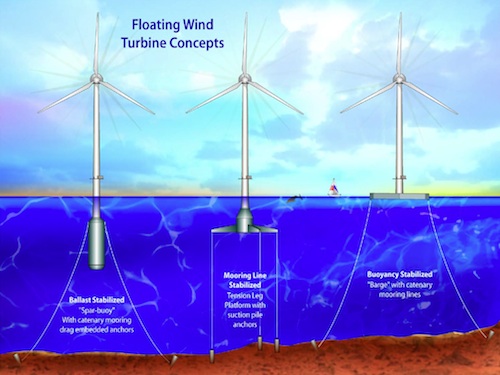The promise of deep offshore wind energy is moving forward rapidly in the wake of the world’s first floating wind turbine, deployed off Norway in September by StatoilHydro. The Gulf of Maine is in line to see similar turbines in coming years, thanks to a focused effort by the National Renewable Energy Lab and regional energy planners. In Massachusetts, plans are progressing for a test deployment of a floating turbine not far from the embattled near-shore Cape Wind site, while in Maine, a public comment period is underway prior to selecting test sites for floating offshore turbines. This Powerpoint presentation (here in pdf format) from a NREL researcher provides a good overview of the current plans in Maine. These deep offshore designs promise to avoid the troublesome noise impacts that have become common with onshore wind farms within a half mile or mile of homes, as well as both visual and noise concerns with near-shore wind farms.
According to EENews (subscription required), energy planners in Maine made the choice to push the new deepwater technology, rather than facing the political hurdles of near-shore wind: “We made the decision at the outset to solve engineering questions and not legal ones,” Habib Dagher said, alluding to legal and political problems faced by Cape Wind. The first deepwater turbines are slated to hit the water by April 2011 in a yet-to-be-determined location in the Gulf of Maine and at a site in the Isle of Shoals. The initial project sites will be 3 nautical miles offshore for ease of access, but commercial models would be 20 miles or more from shore, Dagher said.
EENews, cont’d: The DOE recently awarded the University of Maine $8 million to develop three deepwater offshore floating wind turbines. With $5 million coming from the Energy and Water Appropriations bill and additional state and private funds, the project is expected to have a budget of about $20 million. More than 30 research and industry partners will be tackling the deepwater initiative. The key to the success of the models — ranging in power from 10 to 100 kilowatts — is engineering that keeps the turbines buoyant and lets waves sway them without rocking them from their moorings. One model will be similar to StatoilHydro’s, and the company will be pitching in to assist with the work. “It’s like taking Windows 2.0 and giving it a major upgrade,” explained Habib Dagher, director of the Advanced Structures and Composites Center at the University of Maine, who will be heading up all three projects. Dagher plans to use lighter composite materials than the original Norwegian steel-based model and to make the structure larger.
UPDATE: 12/15 The State of Maine has chosen three sites off its coast, where scale models of several different floating turbine designs will be tested beginning in 2011. And, here’s a link to a quick overview of future-looking developments in offshore wind discussed at the recent European Offshore Wind conference in Stockholm.
UPDATE, 5/30/12: The Maine scale model test has been put off by one year, to 2013, by permitting delays.


March 25th, 2010 at 1:52 pm
[…] bottom-mounted wind turbines on their activities near shore. Habig Dagher, who lead the University of Maine’s offshore wind project, offered a timeline for getting deepwater wind energy going off Maine. “Our goal is build our […]
December 5th, 2011 at 5:32 pm
[…] is not expected to fully mature for 5-10 years. The State of Maine has committed to working to solve the engineering challenges of far-offshore wind, rather than tackle the social challenges of near-shore […]